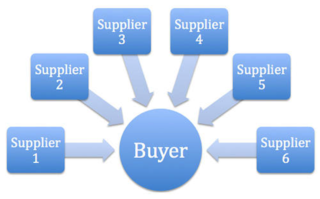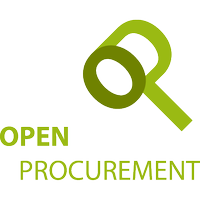UN/CEFACT is the United Nations Centre for Trade Facilitation and Electronic Business. It was established as an intergovernmental body of the United Nations Economic Commission for Europe (UNECE) in 1996 and evolved from UNECE's long tradition of work in trade facilitation which began in 1957.
A request for proposal (RFP) is a document that solicits a proposal, often made through a bidding process, by an agency or company interested in procurement of a commodity, service, or valuable asset, to potential suppliers to submit business proposals.
Procurement is the process of locating and agreeing to terms and purchasing goods, services, or other works from an external source, often with the use of a tendering or competitive bidding process. The term may also refer to a contractual obligation to "procure", i.e. to "ensure" that something is done. When a government agency buys goods or services through this practice, it is referred to as government procurement or public procurement.

A purchase order, often abbreviated to PO, is a commercial document issued by a buyer to a seller, indicating types, quantities, and agreed prices for products or services required. It is used to control the purchasing of products and services from external suppliers. Purchase orders can be an essential part of enterprise resource planning system orders.
An invoice, bill or tab is a commercial document issued by a seller to a buyer relating to a sale transaction and indicating the products, quantities, and agreed-upon prices for products or services the seller had provided the buyer.
Universal Business Language (UBL) is an open library of standard electronic XML business documents for procurement and transportation such as purchase orders, invoices, transport logistics and waybills. UBL was developed by an OASIS Technical Committee with participation from a variety of industry data standards organizations. UBL is designed to plug directly into existing business, legal, auditing, and records management practices. It is designed to eliminate the re-keying of data in existing fax- and paper-based business correspondence and provide an entry point into electronic commerce for small and medium-sized businesses.
Strategic sourcing is the process of developing channels of supply at the lowest total cost, not just the lowest purchase price. It expands upon traditional organisational purchasing activities to embrace all activities within the procurement cycle, from specification to receipt, payment for goods and services to sourcing production lines where the labor market would increase firms' ROI. Strategic sourcing processes aim for continuous improvement and re-evaluation of the purchasing activities of an organisation.
Procurement software refers to a range of business software designed to streamline and automate purchasing processes for businesses and organizations. By managing information flows and transactions between procuring entities, suppliers, and partners, procurement software aims to cut costs, improve efficiency, and boost organizational performance.
In procurement technology, ERFx is an acronym for electronic request for [x], where x can be Proposal (RFP), Quotation (RFQ), Information (RFI) or Tender (RFT). Other pseudonymous acronyms include ITT and PQQ. All relate to a similar activity: a buyer requesting information from potential suppliers for the purpose of evaluation and comparison. Often this is part of a tendering exercise. The more structured this information is, the easier it is to compare the suppliers. For example, it is more effective to ask 20 multiple choice questions than it is to ask 2 essay questions, as long as suppliers have an opportunity to provide commentary to qualify their answers. Therefore, eRFX software should help the buyer to compare suppliers in useful ways – e.g., apples vs. apples.
Government procurement or public procurement is undertaken by the public authorities of the European Union (EU) and its member states in order to award contracts for public works and for the purchase of goods and services in accordance with principles derived from the Treaties of the European Union. Such procurement represents 13.6% of EU GDP as of 2018, and has been the subject of increasing European regulation since the 1970s because of its importance to the European single market.

Government procurement or public procurement is the procurement of goods, services and works on behalf of a public authority, such as a government agency. Amounting to 12 percent of global GDP in 2018, government procurement accounts for a substantial part of the global economy.
Supplier evaluation and supplier appraisal are terms used in business and refer to the process of evaluating and approving potential suppliers by quantitative assessment. The aim of the process is to ensure a portfolio of best-in-class suppliers is available for use, thus, it can be an effective tool to select suppliers in the awarding stage of an auction. Supplier evaluation can also be applied to current suppliers in order to measure and monitor their performance for the purposes of ensuring contract compliance, reducing costs, mitigating risk and driving continuous improvement.
The term Public eProcurement refers, in Singapore, Ukraine, Europe and Canada, to the use of electronic means in conducting a public procurement procedure for the purchase of goods, works or services.
Government procurement in Russia relates to the public procurement in Russia by all governmental, regional and local authorities. The government procurement in Russia represents a big segment of the budgetary expenses. The volume of government purchases makes about 25 trillion rubles in 2015 and 30 trillion rubles in 2016. The government purchases system is constantly modernized due to changes in legislation, technical components and information.
Procure-to-pay is a term used in the software industry to designate a specific subdivision of the procurement process.

A reverse auction is a type of auction in which the traditional roles of buyer and seller are reversed. Thus, there is one buyer and many potential sellers. In an ordinary auction also known as a forward auction, buyers compete to obtain goods or services by offering increasingly higher prices. In contrast, in a reverse auction, the sellers compete to obtain business from the buyer and prices will typically decrease as the sellers underbid each other.

An invitation to tender is a formal, structured procedure for generating competing offers from different potential suppliers or contractors looking to obtain an award of business activity in works, supply, or service contracts, often from companies who have been previously assessed for suitability by means of a supplier questionnaire (SQ) or pre-qualification questionnaire (PQQ).

Prozorro is a public electronic procurement system where state and municipal customers announce tenders to purchase goods, works and services, and business representatives compete for the opportunity to become a state supplier.

OpenProcurement is an open source procurement software toolkit that automates procurement processes. It provides tools to design and build a transparent and competitive procurement process backed by strong data collection, electronic documents, and detailed reporting.
At around £290 billion every year, public sector procurement accounts for around a third of all public expenditure in the UK. EU-based laws continue to apply to government procurement: procurement is governed by the Public Contracts Regulations 2015, Part 3 of the Small Business, Enterprise and Employment Act 2015, and the Public Contracts (Scotland) Regulations of 2015 and 2016. These regulations implement EU law, which applied in the UK prior to Brexit, and also contain rules known as the "Lord Young Rules" promoting access for small and medium enterprise (SMEs) to public sector contracts, based on Lord Young's Review Growing Your Business, published in 2013.





